Physical Address
304 North Cardinal St.
Dorchester Center, MA 02124
Physical Address
304 North Cardinal St.
Dorchester Center, MA 02124

Professional RV drivers reveal their secret techniques for conquering gusty conditions and keeping your rig stable on windy highways.
When winds start whipping around your RV at 30 mph, you’ll quickly realize that driving a house on wheels isn’t for the faint of heart. As an experienced RV owner, you’ve probably felt that white-knuckle grip on the steering wheel during gusty conditions. Whether you’re planning a cross-country adventure or weekend getaway, knowing how to handle your rig in high winds can mean the difference between a safe journey and a nerve-wracking ordeal. Let’s explore the expert techniques that’ll keep you confident behind the wheel.

Before hitting the road in your RV, understanding wind patterns and weather forecasts is essential for a safe journey. Start by checking official weather forecasts and using specialized apps like Drive Weather or RV Trip Wizard to monitor real-time conditions.
Checking weather conditions and monitoring wind patterns before your RV trip can mean the difference between a smooth journey and disaster.
You’ll want to pay special attention to wind speeds, as anything above 30 mph poses significant risks for RVs. Consider using tools like the Windy app for detailed insights into wind conditions along your route.
Study the wind direction for your route, as it’s safer to drive into headwinds than deal with dangerous crosswinds. When planning your trip, look for routes that offer natural wind protection through terrain or vegetation.
Don’t forget to research typical wind patterns for your travel region, especially if you’re heading through deserts, plains, or mountain passes.

Proper weight distribution stands as the foundation of safe RV travel, especially in challenging wind conditions.
You’ll want to focus on maintaining a tongue weight between 10-15% of your trailer’s total weight to prevent dangerous sway situations.
Load your RV strategically by placing about 60% of the weight toward the front. Keep heavier items low and centered, and distribute weight evenly from left to right.
Don’t forget to secure everything to prevent shifting during travel.
A weight distribution hitch is your best friend in high winds. It’ll help stabilize your setup by lifting the back of your tow vehicle while pushing the front axle down. Using a proper WDH setup can help you safely drive in winds up to 40 mph.
Remember to check your hitch setup regularly and maintain proper tire pressure for peak stability.
Keep water tanks balanced and declutter unnecessary items to maintain ideal weight distribution.

Safety-conscious RV drivers understand that thorough pre-trip checks can make the difference between a smooth journey and a risky one, especially when high winds are expected.
Start with your engine checks: inspect fluid levels, look for leaks, and examine belts and hoses for wear. Verify all engine compartment caps are securely fastened before departure.
Regular engine maintenance is your first line of defense – check fluids, watch for leaks, and monitor belts and hoses carefully.
Don’t forget to check your battery connections and fluid levels. Your tires are essential – verify proper pressure, inspect for sidewall damage, and check tread depth, particularly on steering tires.
Before heading out, secure all exterior components. Pull in slide-outs, stow awnings, and disconnect utilities.
Inside, turn off appliances and lock down loose items. Test all your safety devices, including smoke detectors and propane leak detectors.
Finally, verify all lights and signals are working properly – you’ll need them for maximum visibility in challenging conditions.
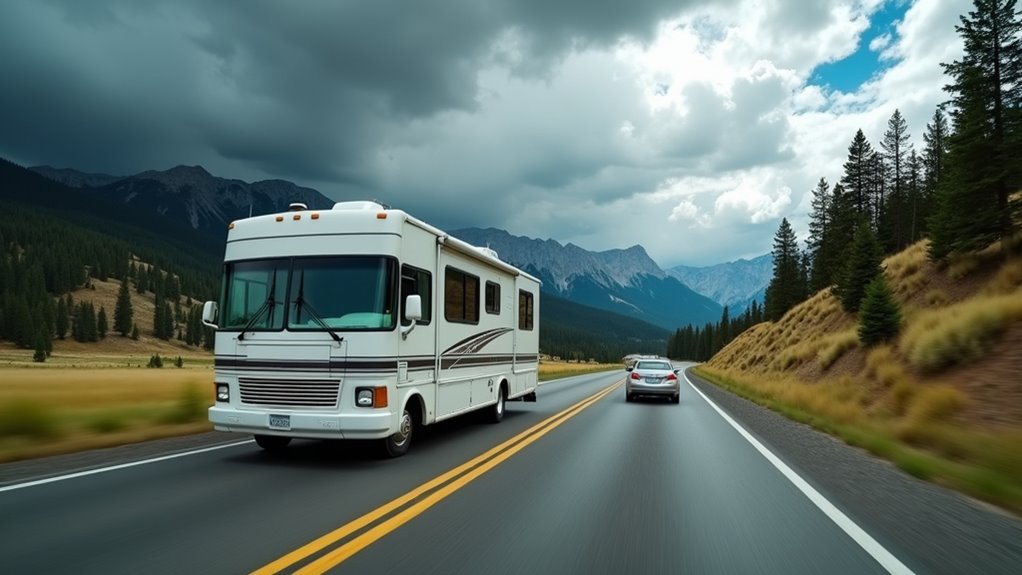
When driving an RV in high winds, your speed directly impacts your safety and control.
You’ll want to adjust your speed based on wind conditions: maintain normal speeds under 20 mph winds, but reduce speed when winds hit 20-30 mph.
When winds reach 30-45 mph, you’re in dangerous territory and should consider stopping. RVs in this range become increasingly unsafe since wind speed thresholds vary based on your vehicle’s length and weight.
Don’t push your luck in winds over 45 mph – your RV becomes extremely vulnerable to rollovers.
Watch for warning signs like feeling unstable or struggling with steering control.
You’ll need to make smooth, gentle corrections and avoid sudden movements that could destabilize your rig.
Keep extra distance between vehicles to account for wind-induced drifting, and use lower gears when needed.

Smart route planning can make the difference between a nerve-wracking journey and a safe one in high winds.
You’ll want to avoid routes through open plains and coastal areas where winds are typically strongest. Instead, look for paths with natural windbreaks like hills or forests.
Use weather apps and wind maps to identify safer routes, and don’t forget to check local reports for specific conditions. Experts recommend avoiding driving when winds exceed 45 miles per hour for optimal safety.
Modern technology makes it easier than ever to plot wind-safe routes – just leverage weather apps and local forecasts for smarter trip planning.
When possible, plan your route so you’re driving into the wind rather than letting it hit your RV from the side.
You’ll also need to identify safe stopping points along the way – preferably locations away from trees, power lines, and other potential hazards.
Join RV community forums to get real-time advice about wind conditions from other travelers who’ve recently driven your planned route.

Taking control of your RV during wind gusts requires mastering specific steering techniques that’ll keep you steady on the road.
Keep both hands firmly on the wheel, but don’t grip too tightly – you’ll need flexibility to respond to sudden gusts.
Position your body centered in the seat and maintain a consistent speed that gives you ideal control. Maintaining 55-60 mph on freeways helps provide optimal stability and control during challenging wind conditions.
When a gust hits, resist the urge to overcorrect. Instead, use gentle, deliberate movements to press against the wind force, similar to how you’d balance against a heavy door.
You’ll want to create space between your RV and other large vehicles, as passing them can create unexpected wind spikes.

Beyond steering techniques, maintaining proper following distance becomes even more important when driving an RV in high winds.
You’ll need to increase your usual following distance considerably to account for reduced visibility and slower reaction times in these conditions.
Keep a watchful eye on other vehicles, especially large trucks and buses, as they’re more likely to sway or drift in strong gusts.
Avoid sudden lane changes, which can destabilize your RV and put you at risk.
If you notice vehicles around you struggling with wind effects, give them extra space – they might swerve unexpectedly.
Monitor traffic patterns closely in all directions, as wind can affect vehicle stability unpredictably.
When in doubt, it’s better to hang back and maintain a generous buffer zone between you and other vehicles.

Before hitting the road in windy conditions, you’ll need to secure all external components of your RV to prevent damage and guarantee safety.
Start by retracting your awnings completely, as they’re particularly vulnerable to wind damage and can create dangerous stress on your RV’s structure.
Don’t forget to secure or store all outdoor furniture and decorative items that could become airborne hazards.
Strong winds can turn patio chairs and garden ornaments into dangerous projectiles, making it crucial to stow them safely before travel.
Close and lock all vents, windows, and storage compartments to reduce wind resistance and prevent unwanted air entry.
Deploy your stabilizers and wheel chocks for added stability, and consider using tire cradles in extreme conditions.
To improve your RV’s stability, fill water tanks and distribute weight evenly throughout the vehicle.
You’ll also want to check all external components regularly for loose parts that could detach during travel.
Keep your tow vehicle connected to your travel trailer whenever possible to provide additional stability during strong winds.

When severe winds make driving unsafe, knowing when and how to pull over your RV can mean the difference between safety and disaster. Monitor your weather apps for wind speeds and be ready to take action when conditions become threatening.
Don’t pull over on busy highway shoulders. Instead, look for designated parking areas or rest stops where you’ll be safely away from traffic. Once you’ve spotted a suitable location, signal early and make your move gradually to maintain stability.
After stopping, turn on your hazard lights and use stabilizers or chocks if needed. Stay put until conditions improve, keeping your emergency supplies and communication devices handy. For added stability in severe weather, ensure your RV has full water tanks before travel.
Use this time to assess your surroundings, check your RV for any wind damage, and plan alternative routes if the severe weather persists.
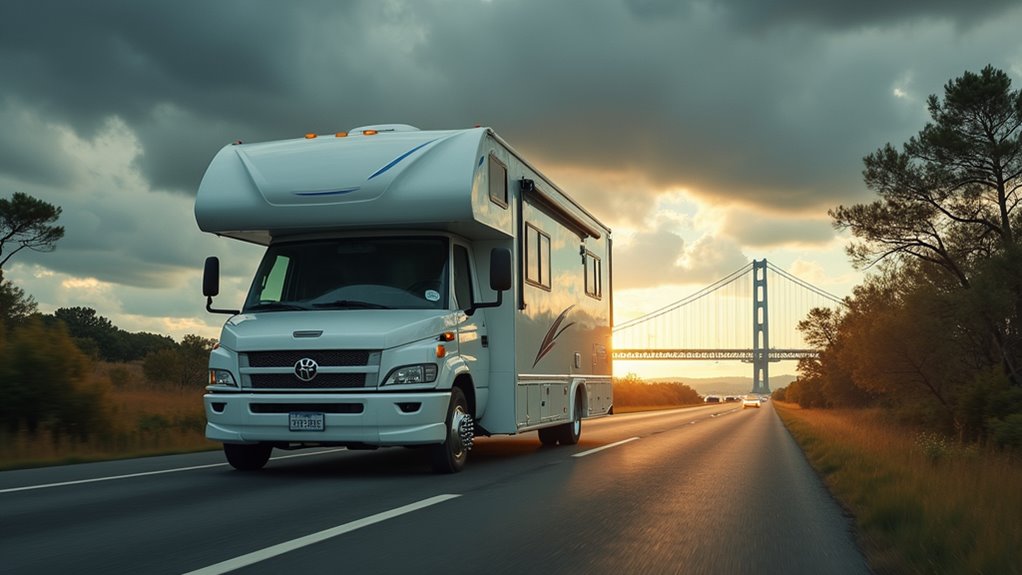
Driving your RV across bridges and open roads during high winds requires extra vigilance and specific safety measures. When approaching bridges, you’ll need to reduce your speed considerably, as winds of 30-50 MPH can destabilize your vehicle.
High winds demand extreme caution when driving an RV. Reduce speed on bridges where strong gusts can quickly compromise vehicle stability.
Keep an eye on weather forecasts and check for bridge closures before your journey. Early morning travel is recommended since wind conditions improve significantly during these hours.
On open roads, don’t exceed 55-60 MPH, and be ready for sudden gusts, especially when passing large vehicles or moving from sheltered areas to exposed ones.
Watch for visual cues like swaying trees to gauge wind conditions. You’ll need to be particularly careful with crosswinds, which pose the greatest risk of flipping your RV.
Maintain proper tire pressure and weight distribution to enhance stability, and consider installing sway control devices if you’re towing a larger trailer.

Successful navigation through wind corridors requires understanding how terrain and geography affect wind patterns.
You’ll want to drive into the wind when possible to reduce its force on your RV, while keeping your speed low for better control. Use your RV’s GPS system for real-time weather updates and ideal route planning.
Pay close attention to terrain changes ahead, as hills, valleys, and narrow passages can intensify wind effects.
When descending from higher elevations, take it slow to maintain stability. Look for natural or man-made windbreaks along your route, and avoid narrow mountain passes where winds tend to be stronger. Limiting your daily drive to 300-400 miles helps prevent fatigue and maintain better control in challenging wind conditions.
Remember to weigh down your RV’s rear end for improved stability, and don’t hesitate to find shelter if conditions become too challenging.
Smart route planning and terrain awareness are your best tools for safe travel.
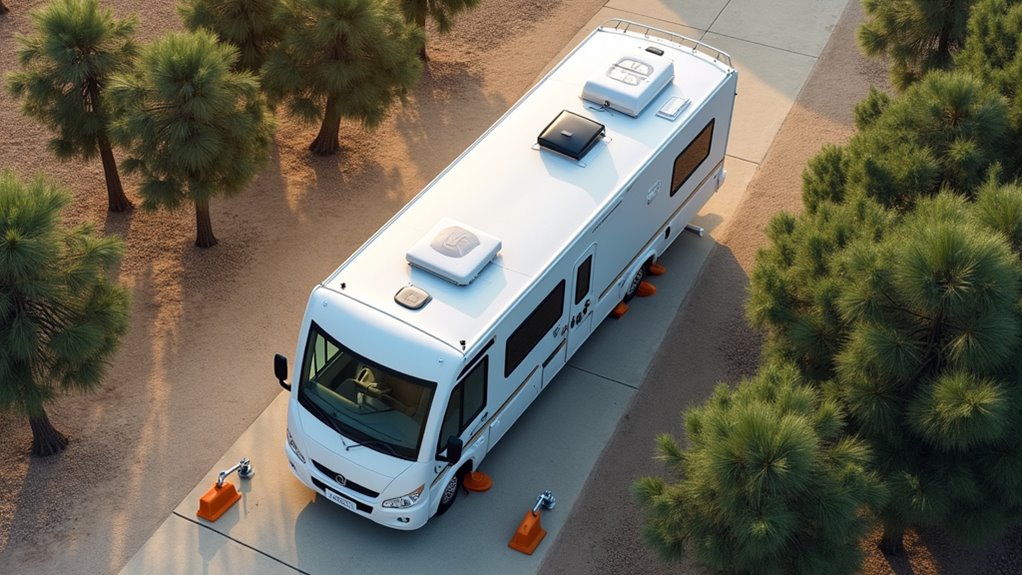
Proper stabilization of your parked RV becomes essential during high winds to prevent dangerous rocking and potential tipping. Position your RV facing directly into the wind, and look for natural windbreaks like hills or buildings for added protection. Hook up your tow vehicle to provide additional stability against strong gusts.
Park into the wind and behind natural windbreaks to keep your RV stable and secure during dangerous high-wind conditions.
You’ll want to deploy all stabilizers and use leveling blocks under tires for maximum steadiness.
To create ideal stability during windy conditions:
Keep monitoring weather conditions and check your stabilization system periodically. If winds become severe, don’t hesitate to move to a sturdy shelter.
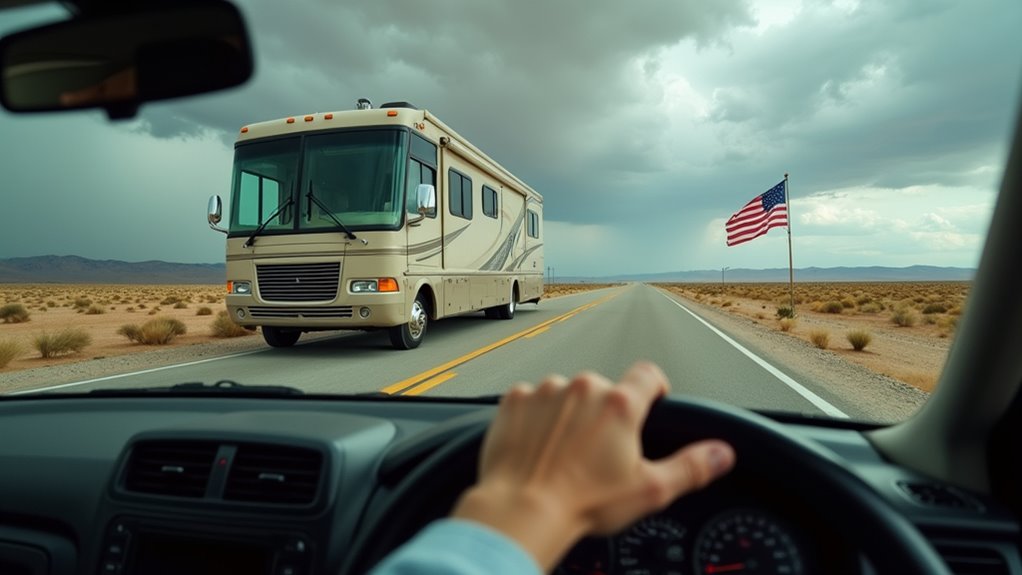
When high winds threaten your RV journey, knowing which road conditions to avoid can mean the difference between a safe trip and a dangerous situation.
Be especially cautious of mountain passes and coastal routes where wind exposure is highest. You’ll want to steer clear of wet roads, construction zones, and areas with potential debris, as these factors compound the risks of driving in high winds.
Watch out for narrow bridges and roads that limit your maneuverability, and pay attention to spots known for frequent wind gusts. RVs have a high center gravity which makes them especially prone to tipping in strong gusts.
If you’re traveling in winds above 30 MPH, you’re putting yourself at significant risk. Remember that even a 10 MPH breeze can affect your RV’s stability, and conditions worsen at 15-20 MPH.
When in doubt, it’s better to wait out dangerous conditions than risk an accident.

Staying informed about dangerous weather conditions requires a reliable alert monitoring system in your RV.
You’ll want to combine multiple alert systems to guarantee you’re never caught off guard by sudden high winds or storms.
These tools work together to give you advance warning of threatening conditions, letting you make quick, informed decisions about when to stop or reroute your RV journey.
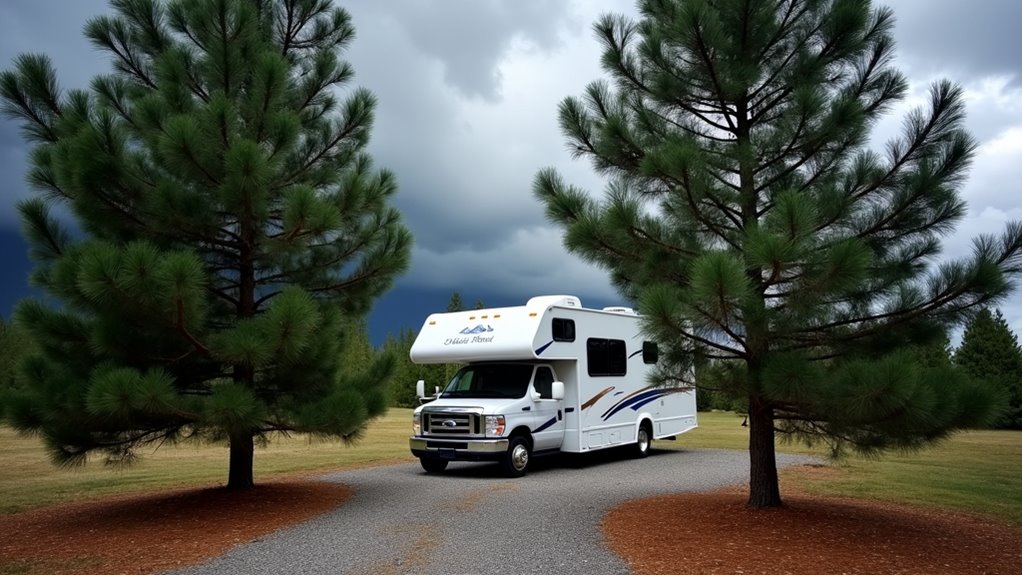
Now that you’ve got your weather alerts set up, selecting the right parking spot can mean the difference between a safe night’s rest and a nerve-wracking experience in high winds.
Always position your RV facing into the wind and look for natural windbreaks like hills or buildings. If you’re in an open area, keep your tow vehicle attached and deploy your stabilizers for extra support. Using larger stabilizer pads will prevent your RV from sinking into soft ground during extended stays.
Don’t forget to fill your water tanks – the added weight helps with stability.
Before settling in, check that you’re on firm, level ground and away from hazardous trees. Bring in your slide-outs and awnings to reduce wind exposure, and secure any loose outdoor items.
If wind speeds are forecasted to exceed 100 mph, know where the nearest emergency shelter is located and be ready to relocate if necessary.
When Mother Nature decides to throw you a curveball, you’re now ready to handle those blustery challenges like a pro. You’ve got the tools to keep your home-on-wheels firmly planted, whether you’re cruising down the highway or settling in for the night. Remember, there’s no shame in pulling over when things get dicey – it’s better to arrive a bit late than to take an unplanned detour into trouble.